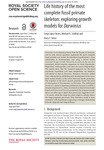Life history of the most complete fossil primate skeleton
| dc.contributor.author | López-Torres, Sergi | en_US |
| dc.contributor.author | Schillaci, Michael A. | en_US |
| dc.contributor.author | Silcox, Mary T. | en_US |
| dc.date.accessioned | 2016-06-25T01:57:04Z | |
| dc.date.available | 2016-06-25T01:57:04Z | |
| dc.date.issued | 2015 | en_US |
| dc.identifier.other | HPU4160304 | en_US |
| dc.identifier.uri | https://lib.hpu.edu.vn/handle/123456789/21685 | en_US |
| dc.description.abstract | Darwiniusis an adapoid primate from the Eocene of Germany, and its only known specimen represents the most complete fossil primate ever found. Its describers hypothesized a close relationship to Anthropoidea, and using a Saimiri model estimated its age at death. This study reconstructs the ancestral permanent dental eruption sequences for basal Euprimates, Haplorhini, Anthropoidea, and stem and crown Strepsirrhini. The results show that the ancestral sequences for the basal euprimate, haplorhine and stem strepsirrhine are identical, and similar to that of Darwinius. | en_US |
| dc.format.extent | 15 p. | en_US |
| dc.format.mimetype | application/pdf | en_US |
| dc.language.iso | en | en_US |
| dc.publisher | The Royal Society | en_US |
| dc.subject | Biology | en_US |
| dc.subject | Palaeontology | en_US |
| dc.subject | Biology | en_US |
| dc.subject | Adapoidea | en_US |
| dc.subject | Strepsirrhini | en_US |
| dc.subject | Haplorhini | en_US |
| dc.subject | Anthropoidea | en_US |
| dc.title | Life history of the most complete fossil primate skeleton | en_US |
| dc.type | Book | en_US |
| dc.size | 955KB | en_US |
| dc.department | Education | en_US |
Files in this item
This item appears in the following Collection(s)
-
Education [806]

